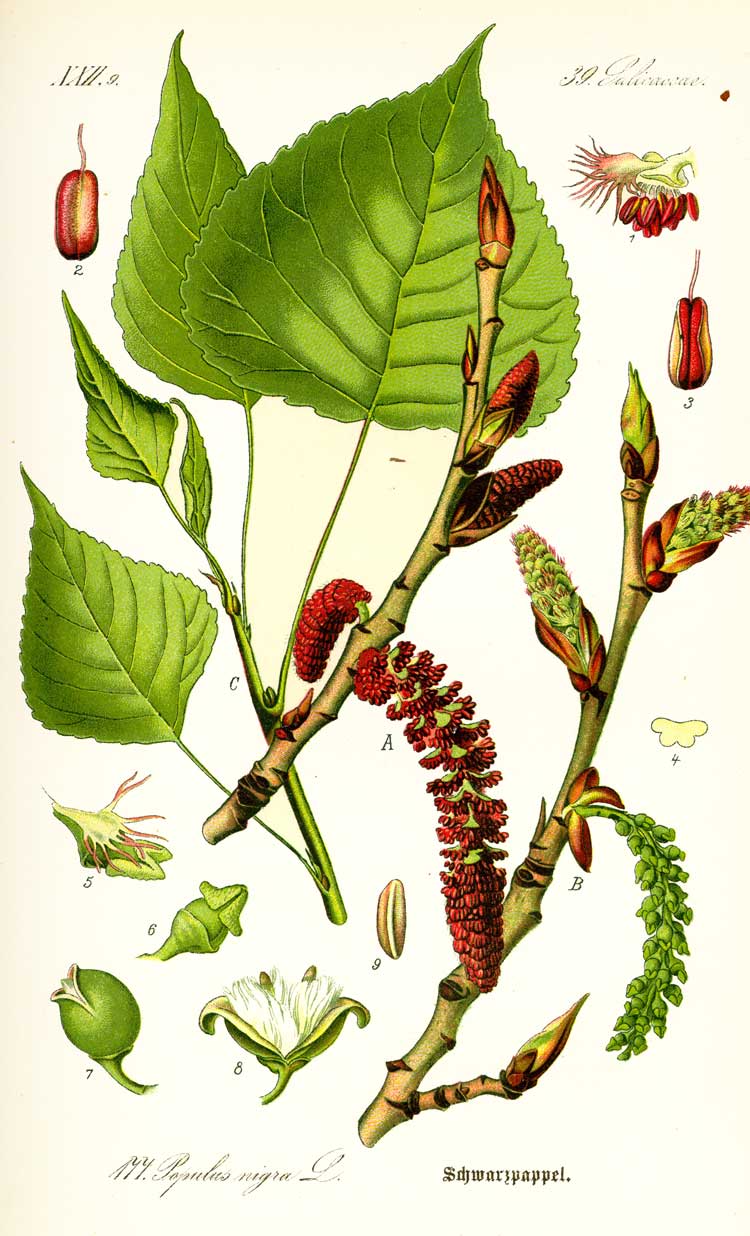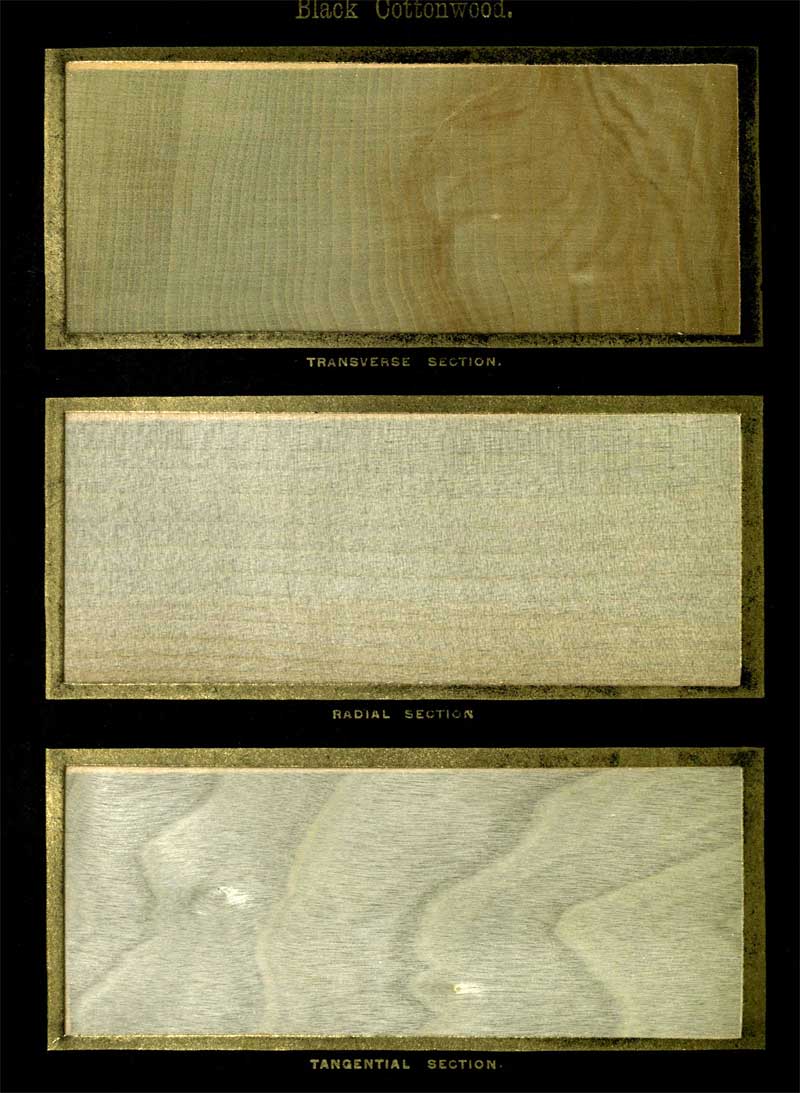
Populus nigra
Classification System: APG IV
Superregnum: Eukaryota
Regnum: Plantae
Cladus: Angiosperms
Cladus: Eudicots
Cladus: Core eudicots
Cladus: Rosids
Cladus: Eurosids I
Ordo: Malpighiales
Familia: Salicaceae
Genus: Populus
Section: Populus sect. Aigeiros
Species: Populus nigra
Subspecies: P. n. subsp. betulifolia – P. n. subsp. caudina – P. n. subsp. nigra
Name
Populus nigra L., Sp. Pl. 2: 1034 (1753).

Populus nigra Wood
References
Linnaeus, C. 1753. Species Plantarum. Tomus II: 1034. Reference page.
Additional references
Komarov, V.L. et al. (eds.). 1934–1964. Flora SSSR. 30 vols. Moscow/Leningrad: Botanicheskii institut, Izdatel'stvo Akademii Nauk SSSR. Reference page.
Fang, C.F., Zhao, S.D. & Skvortsov, B.V. 1999. Populus nigra. Pp. 159 in Wu, Zh.Y. & Raven, P.H. (eds.), Flora of China. Volume 4: Cycadaceae through Fagaceae. Science Press, Beijing & Missouri Botanical Garden Press, St. Louis, ISBN 0-915279-70-3. efloras PDF Reference page.
Links
Hassler, M. 2020. Populus nigra. World Plants: Synonymic Checklists of the Vascular Plants of the World In: Roskovh, Y., Abucay, L., Orrell, T., Nicolson, D., Bailly, N., Kirk, P., Bourgoin, T., DeWalt, R.E., Decock, W., De Wever, A., Nieukerken, E. van, Zarucchi, J. & Penev, L., eds. 2020. Species 2000 & ITIS Catalogue of Life. Published on the internet. Accessed: 2020 October 5. Reference page.
Govaerts, R. et al. 2020. Populus nigra in Kew Science Plants of the World online. The Board of Trustees of the Royal Botanic Gardens, Kew. Published on the internet. Accessed: 2020 October 5. Reference page.
International Plant Names Index. 2020. Populus nigra. Published online. Accessed: 5 October 2020.
Vernacular names
aragonés: Populus nigra
العربية: حور أسود
авар: Чараналъул гъветӏ
azərbaycanca: Qaraqovaq
беларуская (тарашкевіца): Ясакар
беларуская: Ясакар
български: Черна топола
català: Pollancre ver
corsu: Piopu
čeština: Topol černý
Deutsch: Schwarzpappel
dolnoserbski: Carny topoł
Ελληνικά, Κυπριακά: Λεύκη η μαύρη, Καβάτζιν
English: Black Poplar
español: Álamo negro
eesti: Must pappel
euskara: Makal beltz
فارسی: شالک
suomi: Mustapoppeli
français: Peuplier noir
hrvatski: Crna topola
hornjoserbsce: Čorny topoł
magyar: Fekete nyárfa
հայերեն: Բարդի սև
íslenska: Svartösp
italiano: Pioppo nero
日本語: セイヨウハコヤナギ
ქართული: ალვის ხე
қазақша: Бәйтерек ағаш
lietuvių: Juodoji tuopa
македонски: Црна топола
Nederlands: Zwarte populier
norsk: Svartpoppel
polski: Topola czarna
Piemontèis: Arbra nèira
português: Álamo-negro
română: Plop negru
русский: Тополь чёрный
svenska: Svartpoppel
Türkçe: Kara kavak
удмурт: Сьӧд тополь
українська: Тополя чорна
中文: 黑杨
Populus nigra, the black poplar, is a species of cottonwood poplar, the type species of section Aigeiros of the genus Populus, native to Europe, southwest and central Asia, and northwest Africa.[1]
Description
The black poplar is a medium- to large-sized deciduous tree, reaching 20–30 m, and rarely 40 m tall. Normally, their trunks achieve up to 1.5 m in diameter, but some unusual individual trees in France have grown old enough to have much larger trunks – more than 3 meters DBH. Their leaves are diamond-shaped to triangular, 5–8 cm long and 6–8 cm broad, and green on both surfaces.[2]
The species is dioecious, male and female flowers are on different plants, with flowers in catkins and pollination achieved by the wind. The black poplar grows in low-lying areas of moist ground.[3] Like most other pioneer species, the tree is characterized by rapid growth and is able to quickly colonize open areas.[4]
Poplar seed tufts
Subspecies
Three subspecies are established and some botanists distinguish a fourth:[1][2]
P. n. subsp. nigra. Central and eastern Europe. Leaves and shoots glabrous (hairless); bark grey-brown, thick and furrowed.
Burrs and normal bark on a black poplar tree (subspecies betulifolia) in Ayrshire, Scotland.
P. n. subsp. betulifolia (Pursh) W.Wettst. North-west Europe (France, Great Britain, Ireland). Leaf veins and shoots finely downy; bark grey-brown, thick and furrowed, often with heavy burrs, trunk usually heavily leaning.
P. n. subsp. caudina (Ten.) Bugała. Mediterranean region, also southwest Asia if var. afghanica not distinguished.
P. n. var. afghanica Aitch. & Hemsl. (syn. P. n. var. thevestina (Dode) Bean). Southwest Asia; treated as a cultivar of P. nigra by many botanists,[5] and as a distinct species P. afghanica by others;[6] bark smooth, nearly white; leaves and shoots as subsp. caudina (see also cultivars, below).
The subspecies P. n. betulifolia is one of the rarest trees in Great Britain and Ireland,[7][8] with only about 7,000 trees known, of which only about 600 have been confirmed as female.[9]
Cultivars
Several cultivars have also been selected, these being propagated readily by cuttings:
'Italica' is the true Lombardy poplar, selected in Lombardy, northern Italy, in the 17th century. The growth is fastigiate (having the branches more or less parallel to the main stem), with a very narrow crown. Coming from the Mediterranean region, it is adapted to hot, dry summers and grows poorly in humid conditions, being short-lived due to fungal diseases. It is a male clone.[10] As a widely selected species chosen by golf architects[where?] in the 1960s, it soon became apparent that the poplar's very invasive roots destroyed land drainage systems. Decades later, the same courses were removing poplar stands wholesale. Around 40 to 50 years, this short-lived variety starts shedding branches and is very likely to be blown over in high winds, each successive tree lost exposing neighbouring trees, creating a domino effect.
A fastigiate black poplar cultivar of the Plantierensis group, in Hungary
Plantierensis group clones are derived by crossing 'Italica' with P. nigra ssp. betulifolia at the Plantières Nursery near Metz in France in 1884; they are similar to 'Italica' (and often mistaken for it), but with a slightly broader crown, and better adapted to the cool, humid climate of northwest Europe, where the true Lombardy poplar does not grow well. Both male and female clones are grown. This is the tree most commonly grown in Great Britain and Ireland as Lombardy poplar.[10]
'Manchester' is a cultivar of P. nigra subsp. betulifolia widely planted in northwest England. It is a male clone, and currently seriously threatened by poplar scab disease.[11][12]
'Gigantea' is another fastigiate clone, of unknown origin, with a rather broader, more vigorous crown than 'Italica'. It is a female clone.[10]
'Afghanica' (syn. 'Thevestina'): most, if not all, specimens are of a single clone, and many botanists therefore treat it as a cultivar rather than a botanical variety. It is fastigiate, similar to 'Italica', but with a striking whitish bark; it also differs from 'Italica' in being a female clone. This is the common fastigiate poplar in southwest Asia and southeast Europe (the Balkans), where it was introduced during the Ottoman Empire period.[10]
Populus nigra 'Italica' has won the Royal Horticultural Society's Award of Garden Merit.[13]
Distribution
Black poplar has a large distribution area throughout Europe and is also found in northern Africa and central and west Asia. The distribution area extends from the Mediterranean in the south to around 64° latitude in the north and from the British Isles in the west to Kazakhstan and China in the east. The distribution area also includes the Caucasus and large parts of the Middle East.[4]
See also
The Green Cathedral
References
Flora Europaea: Populus nigra
Rushforth, K. (1999). Trees of Britain and Europe. Collins. ISBN 0-00-220013-9.
"Black Poplar". The Woodland Trust. Archived from the original on July 14, 2014. Retrieved July 12, 2014.
Broeck, An Vanden (2003), European black poplar - Populus nigra: Technical guidelines for genetic conservation and use (PDF), European Forest Genetic Resources Programme, p. 6
"Populus nigra var. thevestina". Germplasm Resources Information Network (GRIN). Agricultural Research Service (ARS), United States Department of Agriculture (USDA). Retrieved December 12, 2017.
Flora of Pakistan: Populus afghanica
Milne-Redhead, E. (1990). The B.S.B.I. Black Poplar survey, 1973-88. Watsonia 18: 1-5. Available online Archived 2009-01-09 at the Wayback Machine (pdf file).
Arkive: Populus nigra Archived 2006-02-11 at the Wayback Machine
Cooper, Fiona (2006). The Black Poplar: Ecology, History and Conservation. Windgather Press ISBN 1-905119-05-4
Bean, W. J. (1980). Trees and Shrubs Hardy in the British Isles Vol. 3. John Murray ISBN 0-7195-2427-X
Stace, C. A. (1971). The Manchester Poplar. Watsonia 8: 391-393.
Arboricultural Information Exchange: Manchester Poplar Disease Archived 2007-09-30 at the Wayback Machine
"Populus nigra 'Italica'". RHS. Retrieved 18 January 2021.
Retrieved from "http://en.wikipedia.org/"
All text is available under the terms of the GNU Free Documentation License

